A question that’s loomed large in debates over civics, history, and what’s been labeled “critical race theory” is whether there are still shared values that unite Americans on the left and right. After all, while we all say we want schools to help students grow into virtuous and responsible citizens, it’s not clear we agree on what that actually means. And while debates over these things can fill the media feed, it doesn’t necessarily leave school leaders or policymakers with an idea of how to move forward.
As it turns out, though, there’s at least one place where polling suggests broad, substantial support for an idea with a pretty compelling track record: the success sequence. AEI’s Survey Center on American Life and my AEI education colleague Nat Malkus (remember that I’m a scholar at AEI) in August asked a nationally representative sample of 2,652 adults, with an oversample of 610 parents with children younger than 18, if they think public schools should teach students “that young people who get at least a high school degree, have a job and get married—before having children—are more likely to be financially secure and to avoid poverty”—in other words, the “success sequence.” More than 3 in 4 respondents say they want public schools to teach this. (From here on, for simplicity’s sake, I’ll refer to the survey center’s wording as the “success sequence” when discussing the poll results.)
Now, one might imagine that support for teaching such a pathway would be intuitive. As the Brookings Institution’s Ron Haskins—who, along with Isabel Sawhill, first coined the term “success sequence” a number of years ago—has explained, “Of American adults who followed these three simple rules, only about 2 percent are in poverty.”
But I’ve found that when the success sequence comes up in conversation, many academics and education advocates push back pretty hard. Some critics, such as Philip Cohen, a professor of sociology at the University of Maryland, argue that the “success sequence is bad public policy” as it “rests on assumptions about the future” that “the target population” can’t make. Others worry that it stigmatizes kids and parents in households that haven’t abided by the sequence. And still others think that “the success sequence, trustworthy as it may sound, conveniently frames structural inequalities as matters of individual choice.” (Those pushing back have generally lived out the sequence themselves, which raises some thorny questions.)
Yet, no one is suggesting that following the success sequence is a magical palliative to keep kids from poverty. Nor is anyone implying that adhering to it is as easy as 1-2-3—after all, getting a job requires a willing employer, and getting married requires a willing spouse. What does seem apparent is that the sequence offers a useful, sensible set of guidelines, ones that it would seem like a no-brainer to share with students.
And, as the AEI polling shows, the general public seems to agree—as do parents, of whom 76 percent support teaching the success sequence. And the approval is broad-based. More than 70 percent of Democrats say they favor teaching the success sequence, with just 18 percent opposed. Among Republicans, the split is similar, at 85 percent to 15 percent. Self-identified liberals are net positive by 40 percentage points; self-described conservatives by 70 percent. Sixty-nine percent of millennials support it, as do 83 percent of baby boomers and 90 percent of the Silent Generation. And backing cuts across racial and ethnic groups, with 68 percent of Black non-Hispanic respondents, 80 percent of white respondents, and 74 percent of Hispanic respondents supportive.
The nation has been talking intently in the last few years, as it should be, about opportunity, equality, and the role of systemic impediments. That’s all to the good. But we need to focus not only on the structures and externalities that can shape students’ lives but also on what students can do to control their own destinies. The success sequence is a compelling, evidence-based, broadly appealing way to do both. In our intensely polarized age, it provides a promising path to talk about opportunity, impediments, and responsibility in a way that may help to span some of our bitter divides.






